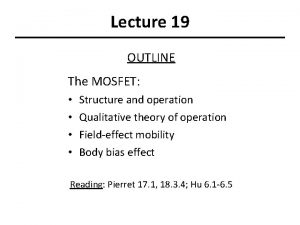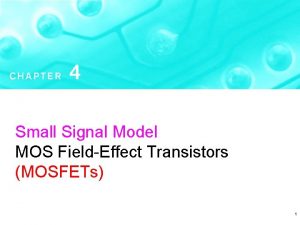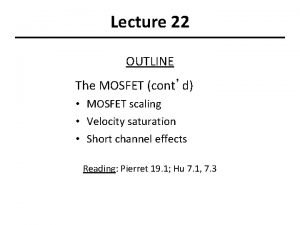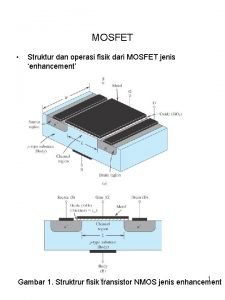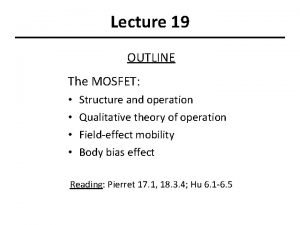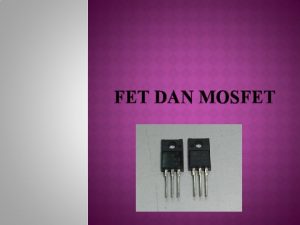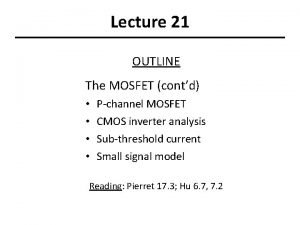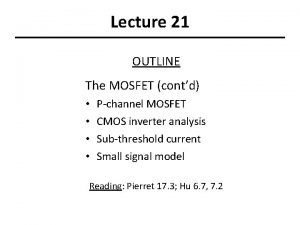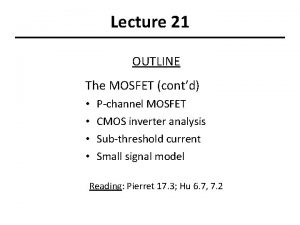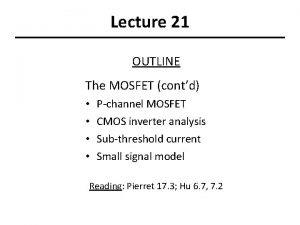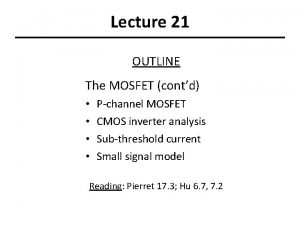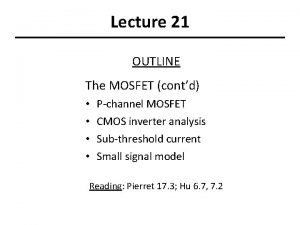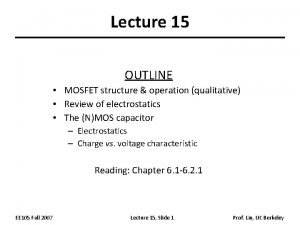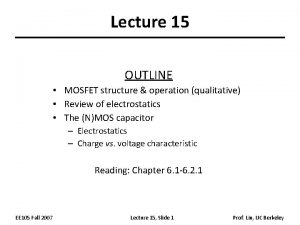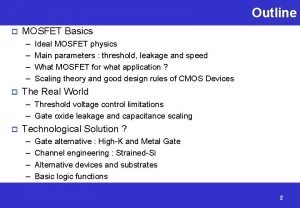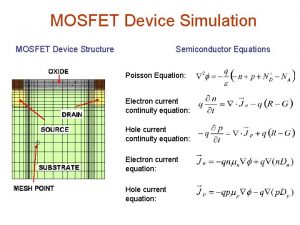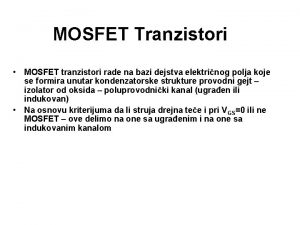Lecture 19 OUTLINE The MOSFET Structure and operation




















- Slides: 20

Lecture 19 OUTLINE The MOSFET: • • Structure and operation Qualitative theory of operation Field-effect mobility Body bias effect Reading: Pierret 17. 1, 18. 3. 4; Hu 6. 1 -6. 5

Invention of the Field-Effect Transistor O. Heil, British Patent 439, 457 (1935) In 1935, a British patent was issued to Oskar Heil. A working MOSFET was not demonstrated until 1955. EE 130/230 A Fall 2013 Lecture 19, Slide 2

Review: NMOS Band Diagrams (Lecture 15, Slide 12) • As VG is increased, electron potential at the Si surface is lowered. increase VG VG = VFB EE 130/230 A Fall 2013 VG < VFB increase VG VT > VG > VFB Lecture 15, Slide 3 R. F. Pierret, Semiconductor Device Fundamentals, Fig. 16. 6

Metal Oxide Semiconductor Field Effect Transistor (MOSFET) • An electric field is applied normal to the surface of the semiconductor (by applying a voltage to an overlying electrode), to modulate the conductance of the semiconductor. ® Drift current flowing between 2 doped regions (“source” & “drain”) is modulated by varying the voltage on the “gate” electrode. EE 130/230 A Fall 2013 Lecture 19, Slide 4 R. F. Pierret, Semiconductor Device Fundamentals, Fig. 17. 1

Modern MOSFETs Metal-Oxide-Semiconductor Field-Effect Transistor: Desired characteristics: • High ON current • Low OFF current GATE LENGTH, Lg OXIDE THICKNESS, xo Intel’s 32 nm CMOSFETs Gate Source Drain Substrate P. Packan et al. , IEDM Technical Digest, pp. 659 -662, 2009 • “N-channel” & “P-channel” MOSFETs operate in a complementary manner “CMOS” = Complementary MOS EE 130/230 A Fall 2013 Lecture 19, Slide 5 CURRENT • Current flowing between the SOURCE and DRAIN is controlled by the voltage on the GATE electrode VT |GATE VOLTAGE| 5

N-channel vs. P-channel NMOS PMOS N+ poly-Si N+ N+ P+ poly-Si P+ p-type Si P+ n-type Si • For current to flow, VGS > VT • For current to flow, VGS < VT to form n-type channel at surface to form p-type channel at surface • Enhancement mode: VT > 0 • Enhancement mode: VT < 0 • Depletion mode: VT > 0 Transistor is ON when VG=0 V EE 130/230 A Fall 2013 Lecture 19, Slide 6 Transistor is ON when VG=0 V

Enhancement Mode vs. Depletion Mode R. F. Pierret, Semiconductor Device Fundamentals, Fig. 18 Enhancement Mode Depletion Mode Conduction between source and drain regions is enhanced by applying a gate voltage A gate voltage must be applied to deplete the channel region in order to turn off the transistor EE 130/230 A Fall 2013 Lecture 19, Slide 7

CMOS Devices and Circuits CIRCUIT SYMBOLS N-channel MOSFET P-channel MOSFET CMOS INVERTER CIRCUIT VOUT VDD S D VIN D GND INVERTER LOGIC SYMBOL VDD VOUT S 0 VDD VIN • When VIN = VDD , the NMOSFET is on and the PMOSFET is off. • When VIN = 0, the PMOSFET is on and the NMOSFET is off. EE 130/230 A Fall 2013 Lecture 19, Slide 8

“Pull-Down” and “Pull-Up” Devices • In CMOS logic gates, NMOSFETs are used to connect the output to GND, whereas PMOSFETs are used to connect the output to VDD. – An NMOSFET functions as a pull-down device when it is turned on (gate voltage = VDD) – A PMOSFET functions as a pull-up device when it is turned on (gate voltage = GND) VDD EE 130/230 A Fall 2013 Pull-up network PMOSFETs only F(A 1, A 2, …, AN) … A 1 A 2 AN … input signals A 1 A 2 AN Pull-down network Lecture 19, Slide 9 NMOSFETs only

CMOS NAND Gate VDD A A 0 0 1 1 B F A B EE 130/230 A Fall 2013 Lecture 19, Slide 10 B 0 1 F 1 1 1 0

CMOS NOR Gate VDD A 0 0 1 1 A B F B EE 130/230 A Fall 2013 A Lecture 19, Slide 11 B 0 1 F 1 0 0 0

CMOS Pass Gate A Y X A EE 130/230 A Fall 2013 Lecture 19, Slide 12 Y = X if A

Qualitative Theory of the NMOSFET VGS < VT : depletion layer The potential barrier to electron flow from the source into the channel region is lowered by applying VGS> VT Inversion-layer VGS > VT : “channel” is formed Electrons flow from the source to the drain by drift, when VDS>0. (IDS > 0) VDS 0 The channel potential varies from VS at the source end to VD at the drain end. VDS > 0 EE 130/230 A Fall 2013 Lecture 19, Slide 13 R. F. Pierret, Semiconductor Device Fundamentals, Fig. 17. 2

MOSFET Linear Region of Operation For small values of VDS (i. e. for VDS << VG VT), where meff is the effective carrier mobility Hence the NMOSFET can be modeled as a resistor: EE 130/230 A Fall 2013 Lecture 19, Slide 14

Field-Effect Mobility, meff Scattering mechanisms: • Coulombic scattering • phonon scattering • surface roughness scattering EE 130/230 A Fall 2013 Lecture 19, Slide 15 C. C. Hu, Modern Semiconductor Devices for Integrated Circuits, Figure 6 -9

MOSFET Saturation Region of Operation VDS = VGS-VT • When VD is increased to be equal to VG-VT, the inversion-layer charge density at the drain end of the channel equals 0, i. e. the channel becomes “pinched off” VDS > VGS-VT • As VD is increased above VG-VT, the length DL of the “pinch-off” region increases. The voltage applied across the inversion layer is always VDsat=VGS-VT, and so the current saturates. ID VDS Lecture 19, Slide 16 R. F. Pierret, Semiconductor Device Fundamentals, Figs. 17. 2, 17 -3

Ideal NMOSFET I-V Characteristics EE 130/230 A Fall 2013 Lecture 19, Slide 17 R. F. Pierret, Semiconductor Device Fundamentals, Fig. 17. 4

Channel Length Modulation • As VDS is increased above VDsat, the width DL of the depletion region between the pinch-off point and the drain increases, i. e. the inversion layer length decreases. If DL is significant compared to L, then IDS will increase slightly with increasing VDS>VDsat, due to “channel -length modulation” IDS VDS EE 130/230 A Fall 2013 Lecture 19, Slide 18 R. F. Pierret, Semiconductor Device Fundamentals, Figs. 17. 2, 17 -3

Body Bias • When a MOS device is biased into inversion, a pn junction exists between the surface and the bulk. • If the inversion layer contacts a heavily doped region of the same type, it is possible to apply a bias to this pn junction. N+ poly-Si + + + + Si. O 2 N+ - - - - - p-type Si EE 130/230 A Fall 2013 • VG is biased so that surface is inverted • n-type inversion layer is contacted by N+ region • If a bias VC is applied to the channel, a reverse bias (VB-VC) is applied between the channel and body Lecture 19, Slide 19

Effect of VCB on f. S, W and VT • Application of a reverse body bias non-equilibrium 2 Fermi levels (one in n-type region, one in p-type region) are separated by q. VBC f. S is increased by VCB • Reverse body bias widens W, increases Qdep and hence VT EE 130/230 A Fall 2013 Lecture 19, Slide 20
 Mosfet structure and operation
Mosfet structure and operation Small signal model fet
Small signal model fet Mosfet
Mosfet Struktur mosfet
Struktur mosfet Mosfet theory of operation
Mosfet theory of operation 01:640:244 lecture notes - lecture 15: plat, idah, farad
01:640:244 lecture notes - lecture 15: plat, idah, farad Lecture outline example
Lecture outline example Lecture outline example
Lecture outline example Lecture outline example
Lecture outline example Lecture outline meaning
Lecture outline meaning Example of sentence outline about education
Example of sentence outline about education Operation management course outline
Operation management course outline Lesson outline structure movement and control
Lesson outline structure movement and control Unorganized points and outline structure
Unorganized points and outline structure Functions of ndma
Functions of ndma Hình ảnh bộ gõ cơ thể búng tay
Hình ảnh bộ gõ cơ thể búng tay Lp html
Lp html Bổ thể
Bổ thể Tỉ lệ cơ thể trẻ em
Tỉ lệ cơ thể trẻ em Voi kéo gỗ như thế nào
Voi kéo gỗ như thế nào Glasgow thang điểm
Glasgow thang điểm
